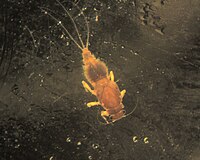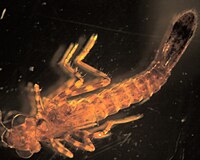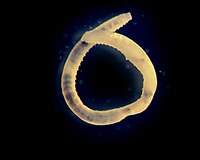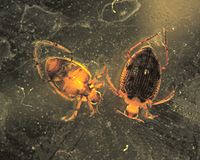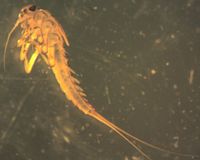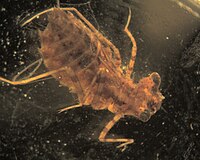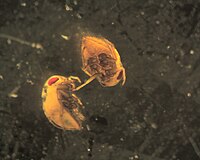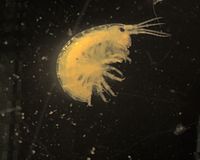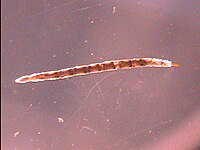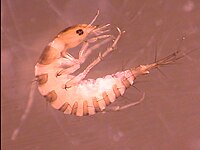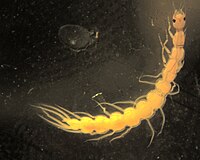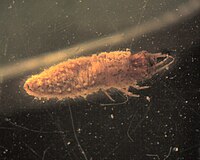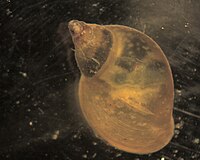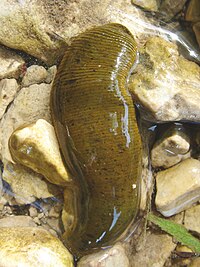Vermont EPSCoR's Streams Project; A Teacher Collaboration on WikiEducator
Openly shared content, practices, and developing resources from Vermont EPSCoR's Streams Project. Join this collaboration and make a difference!
 Schoolhouse ponds |
|---|
|
| Basin: | Winooski |
| State or Province: | Vermont |
| Country: | USA |
| Latitude: | 44.41418 |
| Longitude: | -73.178109 |
| School: | Schoolhouse |
The following are the most common invertebrates collected from the three ponds on the grounds of the Schoolhouse. Samples were taken in August 2008. It might be an interesting project for the current students to see if the same invertebrates are found today or if new species have moved in. You and your teacher can add to this site. If you'd like help contact Declan McCabe at Saint Michael's College.
Chironomidae
- Order
- Diptera
- Family
- Chironomidae
- Common name
- Nonbiting midge
- Tied fly
- Griffith's Gnat
Midge larvae tend to be the most common macroinvertebrate at our sites. As with other Diptera, there are no true jointed legs. Chironomidae do have a pair of prolegs at each end and preserved individuals tend to curl into a 'C'. Identification past family requires slide-mounted heads. We have seen philopotamid caddisflies misidentified with the chironomids and we suspect that that happens when samples are being sorted from trays. Under a microscope, six prominent legs can be seen on members of the caddisfly family Philopotamidae.
More information on Philopotamidae.
Caenis
- Order
- Ephemeroptera
- Family
- Caenidae
- Genus
- Caenis
- Tied fly
- Tiny Graywinged
These mayflies are characterized by square-shaped operculate (plate-like) gills on the second abdominal segment.
Coenagrionidae
- Order
- Odonata
- Family
- Coenagrionidae
- Common name
- narrowwinged damselflies
- Tied fly
- Polly's Green Damsel
These damselfly larvae (sub-order Zygoptera) can be distinguished from dragonfly larvae (sub-order Anisoptera) by their more slender bodies and the presence of three leaf-like gills at the end of the abdomen and The family Coenagrionidae is characterized by its distinctly shaped labium which may or may not be extended.
Images of the gills at the end of abdomen, and another here. An image of the labium, and an extended labium.
Oligochaeta
- Common name
- aquatic earthworms; black worms
Aquatic earthworms lack legs and are characterized by having 20 or more segments. Unlike leeches, they lack a suction disk. We collect members of two or more orders in this class as small numbers of stream sites and they are rarely numerous. They are more common at pond and lake sites.
Image of the 20 or more segments.
Peltodytes
- Order
- Coleoptera
- Family
- Haliplidae
- Genus
- Peltodytes
Both larvae and adults of this family of beetle can be found in ponds. The abdomen of the larvae end in 1-2 long filaments, and long filaments are also found protruding for elsewhere on its body. The adults are characterized by their hind coxae which are greatly expanded and cover the first couple abdominal segments.
Image of the hind coxae.
Baetis
- Order
- Ephemeroptera
- Family
- Baetidae
- Genus
- Baetis
- Common name
- The Little Olive
- Tied fly
- Sawyer Pheasant Tail Nymph
This mayfly has three "tails" and a unique head shape. Its gills are oval shaped and insert dorsally. More mature nymphs have long, dark wing pads.
Image of the long, dark wing pads.
Libellulidae
- Order
- Odonata
- Family
- Libellulidae
- Common name
- Skimmer
These dragonfly larvae (sub-order Anisoptera) can be distinguished from damselfly larvae (sub-order Zygoptera) by their more robust bodies and an abdomen that ends in five 'spikes' as opposed to three gills. The family Libellulidae is characterized by their spoon-shaped mouthparts.They are distinguished from the other family with this trait, Cordulegastridae, by the small rounded teeth on the edges of their palpal lobes.
Images of the spoon-shaped mouthparts, and the small, rounded teeth.
Pleidae
- Order
- Hemiptera
- Family
- Pleidae
This family of Hemiptera has a small, convex body and a 'beak' with 3-4 segments.
Click to see the 'beak'.
Hyalellidae
- Order
- Amphipoda
- Family
- Hyalellidae
The body of this scud is flattened side-to-side. It has seven pairs of walking legs and two pairs of antennae. The first pair of antennae is shorter than the second pair in members of this family.
Ceratopogonidae
- Order
- Diptera
- Family
- Ceratopogonidae
- Common name
- biting midges
Members of this family look like very straight Chironomidae. They are very long and thin with a distinct head capsule and no prolegs. Some in the lab call them 'bamboo sticks' with eyes.
Image of the distinct head capsule.
Dytiscus
- Order
- Coleoptera
- Family
- Dytiscidae
- Genus
- Dytiscus
Adult Dytiscidae have streamlined bodies and hind-legs modified for swimming. They are characterized by the division of the first abdominal segment by the hind coxae. Don't let the paired claws and prominent 'tails' of
Dytiscus larva tempt you to think 'stonefly'; these tails are far less segmented than Plecoptera tails.The head and jaws are also unlike those of stoneflies.
Images of the hind-legs, first abdominal segment, 'tails', Plecoptera tails, and the head and jaws.
Gyrinidae
- Order
- Coleoptera
- Family
- Gyrinidae
Don't let the paired tarsal claws and the filaments on the abdominal segments make you think Megaloptera; it is in fact a whirligig beetle and the adults are familiar surface swimmers. On the 10th abdominal segment, it has 2 pairs of hooks . Adults stand out from others in that they appear to have 2 pairs of eyes. They don't, actually- it's just that its eyes are divided on the exterior by its exoskeleton.
Images of the whirligig beetle, thesurface swimmers, the 2 pairs of hooks and the eyes that are divided.
File:Gyrinidae_side_view.jpg
Hydrophilidae
- Order
- Coleoptera
- Family
- Hydrophilidae
This beetle has one tarsal claw at the end of each leg. It is characterized by conspicuous mandibles and also several simple eyes instead of compound eyes. Click to see the
conspicuous mandibles and the
simple eyes.
Lymnaeidae
Members of the family Lymnaeidae belong in the class of Gastropoda. Members contain a single, coiled shell with a right-handed spiral. Differing from those of Planorbidae, members of Lymnaeidae have a larger opening. Respiration in these snails are through lung-like structures. Preferred habitats include those with slow streaming waters and heavy vegetation. These right handed snails are somewhat less tolerant of water pollution than our other common snails.
Images of the family Lymnaeidae and the class Gastropoda.
Hirudinea
Leeches have bodies with 20 or more segments and a ventral suction disk on at least one end, though sometimes on both ends. They are segmented worms (Phylum Annelida) in the Class Hirudinea. Most of the leeches we sample come from ponds and lakes but they are also commonly found in streams.
Image of the ventral suction disk.


